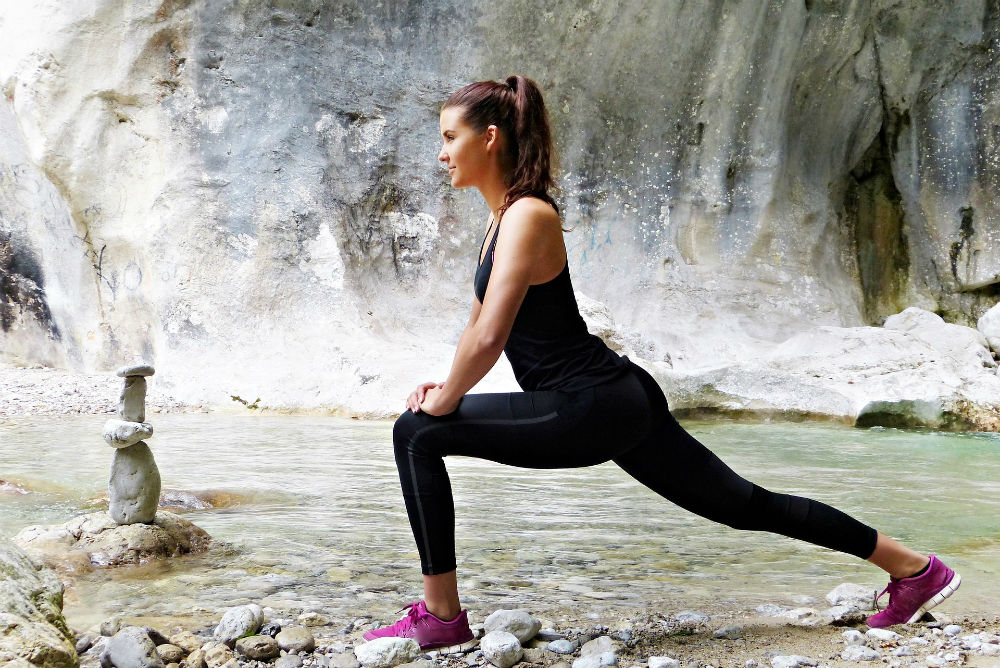
The question of whether to stretch, when to stretch and how much is one that the sporting world has been debating for years. While some people swear by doing stretches before training, others are convinced that only stretching after exercise can be beneficial. pjuractive is here to try to get to the bottom of it.
Why stretch at all?
In principle, the aim of stretching is to accelerate recovery, improve flexibility, prevent sore muscles and avoid injuries. There are also two types of stretching: static stretching and dynamic stretching:
- Static stretching means that you assume a position and stay in it. Reaching down to touch your toes from a standing position and staying there for a few seconds is an example of static stretching.
- Dynamic stretching on the other hand is stretching while moving. So unlike static stretches, you don’t hold a position. Instead, for example, you raise one leg and then rock your upper body repeatedly toward that raised leg.
We can differentiate between three different applications for stretching:
- Pre-stretching to warm up
- Post-stretching to warm down
- Stretching as a separate training session
The importance of stretching before exercise
We usually refer to stretching before exercise as a warm-up. Experts recommend dynamic stretching for this. That’s because dynamic stretching warms up your muscles, tendons and ligaments – activating the tissues in your body, preventing injury and preparing your body properly for the exercise you’re about to do. It’s best for athletes to choose a warm-up that’s specific to their sport. That means runners should focus on their thighs or hips, for example. You should avoid static stretches before exercising, as experts say they can even result in reduced performance or an increased risk of injury. Straining appears to make the muscles tighter, increasing the basic stress on your muscles before the actual physical exertion begins and that can be dangerous. Dynamic stretching, on the other hand, can be important before exercise.
The importance of stretching after exercise
While dynamic stretching can be a good idea before exercise, static stretches are more suitable after exercise or even on training-free days to keep your muscles flexible and help with muscle regeneration. Again, when stretching after a training session, it’s important to stretch the muscles you were working during training. So here too it’s important to follow a stretching program that’s specific to your sport. If you want to help keep your muscles flexible on training-free days as well, use these days to stretch any muscles that you want to work on.
How long to stretch before and after exercise
If you know what kind of stretching you want to do, then it’s just a question of how long you should stretch before or after a training session. A few stretches will usually be enough – six, for example. The important thing is to make sure you hold each stretch for at least 30 seconds (for static stretches), or stay moving for at least 30 seconds (for dynamic stretches). Physiotherapists even recommend up to 60 seconds. Never make your stretches too short – otherwise they’ll barely have any effect. But you should also think about when to stretch and how often. People often assume that the more you do, the better it is. But if you stretch every day, you run the risk of putting too much strain on your muscles. It’s better to do a few dynamic stretches before training that are tailored to the workout you’re going to be doing and that will prepare your muscles properly. Static exercises should either be done after you’ve finished a training session – again, a few exercises are enough to relax the muscles that have just been working hard – or you can do them as a separate training session on a training-free day.

Stretches
The stretches you choose for your training session should always be in line with your goals, too. Runners should do different stretches to swimmers, for example. We’ve picked out a few stretches that can be particularly beneficial for runners:
Calves: These can really take a punishing when you’re running, so it’s a good idea to include calf stretches in your training plan. Simply stand with your toes and the ball of your foot up against a box or a wall and lean your upper body forward. This stretches the calves out. The steeper the angle between your foot and the box or wall, the more intense the stretch. Then switch to the other foot after 60 seconds.
Adductors: You can stretch your adductors by sitting with the soles of your feet together and drawing your heels in toward your body. To feel the stretch, try to push your knees down as close to the floor as possible. It’s best to put your hands behind your back to support you.
Thighs: When it comes to your thighs, it’s important to note that there are different stretches for the front of the thighs and the backs of the thighs. To stretch the front of your thighs, go into a deep lunge. Your front leg should roughly form a right angle. Then draw the foot of your rear leg up toward your butt. Hold your leg below the ankle as you do this – don’t pull on your foot. To stretch the backs of your thighs, stand upright, then cross your feet, bend your upper body forwards and try to touch the floor with your fingers. Keep your heels on the floor as you do this. After 60 seconds, swap your feet over.
As you’ve seen, stretching isn’t always necessarily beneficial. In any case, you should always choose stretches that are appropriate for your sport and that will benefit you. Listen to your body. If you notice you find a particular stretch uncomfortable, then you’re best off eliminating it from your training plan ?